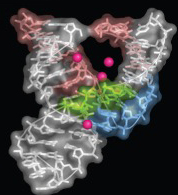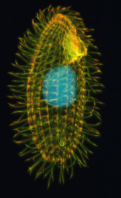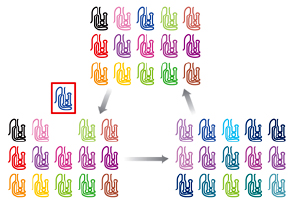Self-Organizing & Replicating Molecules:
The unicellular eukaryote, Tetrathymena, has an RNA intron with the capacity to remove itself for an original RNA and self-spllce the one RNA piece, with a new covalent bond, linking the two loose ends of the excised RNA by catalyzing a ligation reaction. Study of this Tetrhymena ribozyme provides much of the experimental evidence support of the RNA-World hypothesis and RNA as a key player in the origin of life.

CpU + GPN + ribozyme -----> CpUpN + G + ribozyme
Researchers wanted to see
how many bases could be polymerized by this self-splicing
ribozyme. In experiments to see it the ribozyme
would add new nucleotides to an existing short (5
nucleotide) RNA showed it showed some polymerase activity,
even in the absence of added RNA dinucleotides and would
double the RNA length in about 1 hour, but without adding
a G-nulceotides. Its slow rate suggested it is not a
robust enough RNA polymerase.

By modifying the blue one and selecting until you get the fastest ribozyme polymerase, the researchers produced 25 of the fastest ribozymes that had, all of which had many bases in common.
The investigators eventually built one synthetic ribozyme that could catalyze RNA polymerization at about 100 bases per minute, some 700 times faster than the biological one isolated from Tetrahymena. By comparing the old and new ribozyme sequences the investigators could determine which bases were critical for the enhanced function.

These
RNA World experiments establish that biologically relevant
molecules could be produced abiotically.
We know that RNA-based enzymes were first hypothesized and
later found in nature and that abiotic
ribozymes are capable of polymerizing RNA
molecules very quickly. In short, ribozyme RNA polymerases
do exist and may have been the first genetic information
replicators. Ribozyme RNA polymerases satisfy two of our
criteria for the bare minimal requirements for the origin
of life: replication and change over time.
back